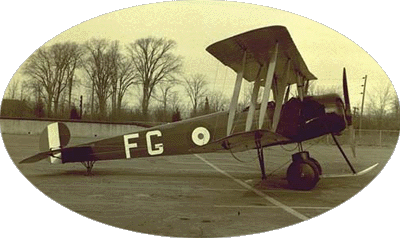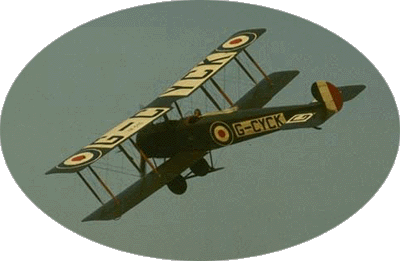Avro 504Ks [Mid 1920's]

My first flights were in an Avro 504K which was a FIRST world war plane and had a rotary engine (the whole engine to which the prop was attached rotated around a stationary crankshaft) and a wooden "hockey stick" projected between the wheels to save the propeller in case of turning over on landing! The pilot was a Captain Sparks (the same as my name but without the "e"). He was a first world war pilot who bought a war surplus plane to make a living giving people "joy rides" @ 5/- a flight. (25p but worth very much more at the time.) I was , I think, about nine and he took a fancy to me because he was flying from a farm field nearby and I ran errands for him. What boy wouldn't? So since the planes, at that time, often needed attention; engine tuning , fabric 'doped' etc: and a flight each time to check them out, I had many hours passenger flying in my "near childhood" and because of my obsession blackmailed him into letting me tag along each time there was an excuse. For some reason or other these test flights were known as "prop flights".
The rotary engined planes flew with open throttle the whole time and they landed by cutting out the ignition with a button on the control column which was then called the "Joystick"! You will appreciate that as the plane came in to land it's rate of descent was controlled by 'blips' and each time there was a wild swerve because of the gyroscopic force of the heavy rotary engine. This gave some of the fighters of that time one of their most dramatic characteristics. They could turn on a coin to the port but were hopeless turning to starboard. (I have a 50/50% chance of getting that right!!!)
I was very proud and the envy of my friends! I may even have hinted that he could be a relative.
When he left for pastures new he gave me a worn ball race. The one about which the engine rotated; it was huge. Wish I still had it. Within a few weeks I was shown a newspaper cutting reporting his death in a crash. At that age it took some time to recover from the shock.
The engine had failed as he was climbing away on takeoff. He tried to turn back to the field. A cardinal sin and almost unbelievably stupid. Everyone is taught of the crassness of doing it and yet one of the greatest of British pilots died this way.
What happens is that the aircraft, deprived of power, is near the stall so the only thing to do is to put the nose down to gain speed to regain control. Any attempt to turn means that the wing on the inside of the turn loses yet more speed and promptly stalls into a spin. At that height there is no hope of recovery. Even if there are obstacles in front -- the impact speed will be lower and you are going to prang anyway!
My next reinforcement of obsession came when I was about thirteen and discovered that my deputy headmaster had been a pilot in WWI. He had flown RE8s. Not as glamorous as Sopwith Camels, S.E.5s, Spads or even Fokker D VIIs but I was actually *talking* to a pilot. I am sure that he took detours to avoid me!!!

The days of *real* flying.
Next: - My 21st
Edward Sparkes ©1998